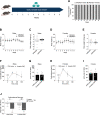Chemogenetic activation of CRF neurons as a model of chronic stress produces sex-specific physiological and behavioral effects
- PMID: 37833589
- PMCID: PMC10724197
- DOI: 10.1038/s41386-023-01739-5
Chemogenetic activation of CRF neurons as a model of chronic stress produces sex-specific physiological and behavioral effects
Abstract
Trauma and chronic stress exposure are the strongest predictors of lifetime neuropsychiatric disease presentation. These disorders often have significant sex biases, with females having higher incidences of affective disorders such as major depression, anxiety, and PTSD. Understanding the mechanisms by which stress exposure heightens disease vulnerability is essential for developing novel interventions. Current rodent stress models consist of a battery of sensory, homeostatic, and psychological stressors that are ultimately integrated by corticotropin-releasing factor (CRF) neurons to trigger corticosteroid release. These stress paradigms, however, often differ between research groups in the type, timing, and duration of stressors utilized. These inconsistencies, along with the variability of individual animals' perception and response to each stressor, present challenges for reproducibility and translational relevance. Here, we hypothesized that a more direct approach using chemogenetic activation of CRF neurons would recapitulate the effects of traditional stress paradigms and provide a high-throughput method for examining stress-relevant phenotypes. Using a transgenic approach to express the Gq-coupled Designer Receptor Exclusively Activated by Designer Drugs (DREADD) receptor hM3Dq in CRF-neurons, we found that the DREADD ligand clozapine-N-oxide (CNO) produced an acute and robust activation of the hypothalamic-pituitary-adrenal (HPA) axis, as predicted. Interestingly, chronic treatment with this method of direct CRF activation uncovered a novel sex-specific dissociation of glucocorticoid levels with stress-related outcomes. Despite hM3Dq-expressing females producing greater corticosterone levels in response to CNO than males, hM3Dq-expressing males showed significant typical physiological stress sensitivity with reductions in body and thymus weights. hM3Dq-expressing females while resistant to the physiological effects of chronic CRF activation, showed significant increases in baseline and fear-conditioned freezing behaviors. These data establish a novel mouse model for interrogating stress-relevant phenotypes and highlight sex-specific stress circuitry distinct for physiological and limbic control that may underlie disease risk.
© 2023. The Author(s).
Conflict of interest statement
The authors declare no competing interests.
Figures




References
-
- Grant JK, Forrest APM, Symington T. The secretion of cortisol and corticosterone by the human adrenal cortex. Acta Endocrinologica (Nor) 1957;26:195–203. - PubMed
-
- Brown KI. The validity of using plasma corticosterone as a measure of stress in the Turkey. Proc Soc Exp Biol Med. 1961;107:538–42. doi: 10.3181/00379727-107-26680. - DOI
MeSH terms
Substances
Grants and funding
LinkOut - more resources
Full Text Sources

